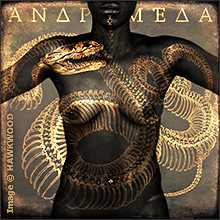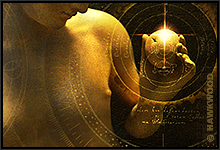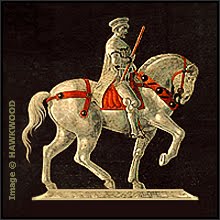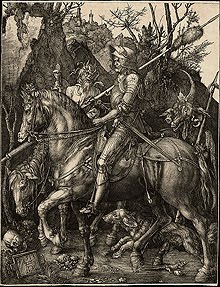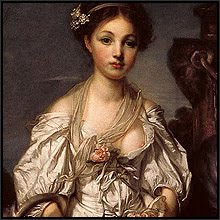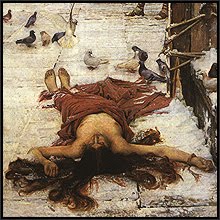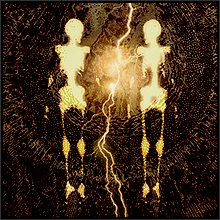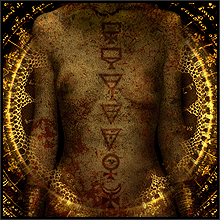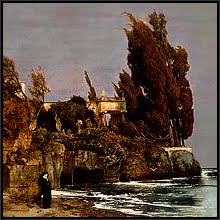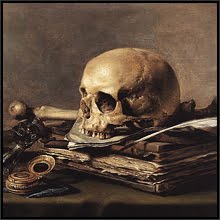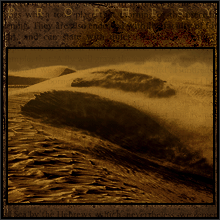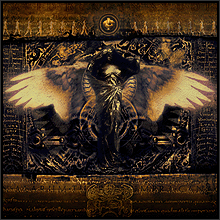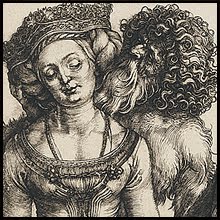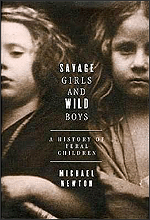In full Gothic *armour a knight rides purposefully through a rocky ravine (below). His gaze is fixed firmly upon the way ahead, denying himself the distractions that might lie to either side of his chosen path. Under the very hooves of his steed a lizard scuttles to safety. On the stump of a tree lies a human skull, a grim reminder of the folly and illusion of human vanity. A hound, the knight’s faithful companion on his lonely journey, runs alongside.
 The knight is escorted or harrased by two beings: on the knight’s right the figure of Death raises his hourglass (below), reminding the knight that his mortal days are already numbered and noted. Death’s mount, a scrawny nag, wears a bell around its neck: both the bell and the hourglass convey the passing of time. Behind the knight strides the horned and cloven-hoofed Devil, shouldering a pikestaff.
The knight is escorted or harrased by two beings: on the knight’s right the figure of Death raises his hourglass (below), reminding the knight that his mortal days are already numbered and noted. Death’s mount, a scrawny nag, wears a bell around its neck: both the bell and the hourglass convey the passing of time. Behind the knight strides the horned and cloven-hoofed Devil, shouldering a pikestaff.
 In his portrayal of the figure of Death, the artist has avoided the conventional ‘grim reaper’ approach. We see here no skeletal hand clutching a scythe; Dürer’s treatment is more tied to grim reality, and the more compelling for it. On the face the dried skin stretches taughtly away from the bone, exposing the skull beneath. Medusa-like serpents writhe and coil, entwining themselves around the crown of Lord Death, although here their appearance has more of the worms of the grave than of scaled and glittering snakes. The matted and straggling pale hair and beard which frame the terrible face are portrayed with the unflinching conviction of a 16th century observer who had encountered such a face often enough, perhaps beside some infrequently-used country road, and certainly on a gibbet.
In his portrayal of the figure of Death, the artist has avoided the conventional ‘grim reaper’ approach. We see here no skeletal hand clutching a scythe; Dürer’s treatment is more tied to grim reality, and the more compelling for it. On the face the dried skin stretches taughtly away from the bone, exposing the skull beneath. Medusa-like serpents writhe and coil, entwining themselves around the crown of Lord Death, although here their appearance has more of the worms of the grave than of scaled and glittering snakes. The matted and straggling pale hair and beard which frame the terrible face are portrayed with the unflinching conviction of a 16th century observer who had encountered such a face often enough, perhaps beside some infrequently-used country road, and certainly on a gibbet.
 As with Dürer’s depiction of Death, his Devil as well denies us the option of a comfortable way out (above). There is nothing to snigger at here; no hint of capering caricature which allows us reassuringly to say to ourselves, ‘see, he’s not real after all…’. On the contrary, Dürer has forced in front of our gaze a horror so minutely observed in its detail that it presents the impression that it almost could be classified by science. From the bizarre curving horn that arcs above its head to the grotesque drooping wattles which hang beneath its grimacing snout, every changing texture of horn, hair, flesh and fangs has been captured with the same apparent accuracy of observation and fidelity to reality that the artist used to portray the exotic animals which he later encountered in the Antwerp Zoo. Even the rolling-eyed squint seems unnerving rather than comical: is the Devil looking directly at us, or not? When the Devil looks like this, we may hope that his attentions fall elsewhere.
As with Dürer’s depiction of Death, his Devil as well denies us the option of a comfortable way out (above). There is nothing to snigger at here; no hint of capering caricature which allows us reassuringly to say to ourselves, ‘see, he’s not real after all…’. On the contrary, Dürer has forced in front of our gaze a horror so minutely observed in its detail that it presents the impression that it almost could be classified by science. From the bizarre curving horn that arcs above its head to the grotesque drooping wattles which hang beneath its grimacing snout, every changing texture of horn, hair, flesh and fangs has been captured with the same apparent accuracy of observation and fidelity to reality that the artist used to portray the exotic animals which he later encountered in the Antwerp Zoo. Even the rolling-eyed squint seems unnerving rather than comical: is the Devil looking directly at us, or not? When the Devil looks like this, we may hope that his attentions fall elsewhere.
 With the creation of The Knight, Death and the Devil, Dürer’s engraving burin appears almost to have taken on a life of its own, seeming thoroughly at home among this controlled churning of matted hair and metal, of rock and bone and stunted vegetation. The Devil’s crescent horn almost scoops the background wall of rock along with it in a fluid wave of engraved curves. The neck muscles of the knight’s horse seem more sculpted than engraved (above).
With the creation of The Knight, Death and the Devil, Dürer’s engraving burin appears almost to have taken on a life of its own, seeming thoroughly at home among this controlled churning of matted hair and metal, of rock and bone and stunted vegetation. The Devil’s crescent horn almost scoops the background wall of rock along with it in a fluid wave of engraved curves. The neck muscles of the knight’s horse seem more sculpted than engraved (above).
 Dürer's house in Nuremberg was not far from an *armourer's, and the artist would have seen such knights in life. His watercolor study (above) clearly served the artist as a reference for his engraving. Although it has been suggested that the idea of the noble knight had by Dürer's time declined, this is only partly true. Knights always were a *mercenary class, even something of a rabble, and our own ideas of chivalry belong to the pages of romantic fiction.
Dürer's house in Nuremberg was not far from an *armourer's, and the artist would have seen such knights in life. His watercolor study (above) clearly served the artist as a reference for his engraving. Although it has been suggested that the idea of the noble knight had by Dürer's time declined, this is only partly true. Knights always were a *mercenary class, even something of a rabble, and our own ideas of chivalry belong to the pages of romantic fiction.
 The statuesque bearing of the knight’s mount evidently drew its inspiration from Leonardo da Vinci’s sketch (above) of his proposed equestrian statue of Francesco Sforza, the Duke of Milan, which Dürer would have seen on his Italian trip. When Leonardo’s sketch is reversed, as shown here, the similarity to Dürer’s own drawing is readily apparent.
The statuesque bearing of the knight’s mount evidently drew its inspiration from Leonardo da Vinci’s sketch (above) of his proposed equestrian statue of Francesco Sforza, the Duke of Milan, which Dürer would have seen on his Italian trip. When Leonardo’s sketch is reversed, as shown here, the similarity to Dürer’s own drawing is readily apparent.
 The knight is escorted or harrased by two beings: on the knight’s right the figure of Death raises his hourglass (below), reminding the knight that his mortal days are already numbered and noted. Death’s mount, a scrawny nag, wears a bell around its neck: both the bell and the hourglass convey the passing of time. Behind the knight strides the horned and cloven-hoofed Devil, shouldering a pikestaff.
The knight is escorted or harrased by two beings: on the knight’s right the figure of Death raises his hourglass (below), reminding the knight that his mortal days are already numbered and noted. Death’s mount, a scrawny nag, wears a bell around its neck: both the bell and the hourglass convey the passing of time. Behind the knight strides the horned and cloven-hoofed Devil, shouldering a pikestaff. In his portrayal of the figure of Death, the artist has avoided the conventional ‘grim reaper’ approach. We see here no skeletal hand clutching a scythe; Dürer’s treatment is more tied to grim reality, and the more compelling for it. On the face the dried skin stretches taughtly away from the bone, exposing the skull beneath. Medusa-like serpents writhe and coil, entwining themselves around the crown of Lord Death, although here their appearance has more of the worms of the grave than of scaled and glittering snakes. The matted and straggling pale hair and beard which frame the terrible face are portrayed with the unflinching conviction of a 16th century observer who had encountered such a face often enough, perhaps beside some infrequently-used country road, and certainly on a gibbet.
In his portrayal of the figure of Death, the artist has avoided the conventional ‘grim reaper’ approach. We see here no skeletal hand clutching a scythe; Dürer’s treatment is more tied to grim reality, and the more compelling for it. On the face the dried skin stretches taughtly away from the bone, exposing the skull beneath. Medusa-like serpents writhe and coil, entwining themselves around the crown of Lord Death, although here their appearance has more of the worms of the grave than of scaled and glittering snakes. The matted and straggling pale hair and beard which frame the terrible face are portrayed with the unflinching conviction of a 16th century observer who had encountered such a face often enough, perhaps beside some infrequently-used country road, and certainly on a gibbet. As with Dürer’s depiction of Death, his Devil as well denies us the option of a comfortable way out (above). There is nothing to snigger at here; no hint of capering caricature which allows us reassuringly to say to ourselves, ‘see, he’s not real after all…’. On the contrary, Dürer has forced in front of our gaze a horror so minutely observed in its detail that it presents the impression that it almost could be classified by science. From the bizarre curving horn that arcs above its head to the grotesque drooping wattles which hang beneath its grimacing snout, every changing texture of horn, hair, flesh and fangs has been captured with the same apparent accuracy of observation and fidelity to reality that the artist used to portray the exotic animals which he later encountered in the Antwerp Zoo. Even the rolling-eyed squint seems unnerving rather than comical: is the Devil looking directly at us, or not? When the Devil looks like this, we may hope that his attentions fall elsewhere.
As with Dürer’s depiction of Death, his Devil as well denies us the option of a comfortable way out (above). There is nothing to snigger at here; no hint of capering caricature which allows us reassuringly to say to ourselves, ‘see, he’s not real after all…’. On the contrary, Dürer has forced in front of our gaze a horror so minutely observed in its detail that it presents the impression that it almost could be classified by science. From the bizarre curving horn that arcs above its head to the grotesque drooping wattles which hang beneath its grimacing snout, every changing texture of horn, hair, flesh and fangs has been captured with the same apparent accuracy of observation and fidelity to reality that the artist used to portray the exotic animals which he later encountered in the Antwerp Zoo. Even the rolling-eyed squint seems unnerving rather than comical: is the Devil looking directly at us, or not? When the Devil looks like this, we may hope that his attentions fall elsewhere. With the creation of The Knight, Death and the Devil, Dürer’s engraving burin appears almost to have taken on a life of its own, seeming thoroughly at home among this controlled churning of matted hair and metal, of rock and bone and stunted vegetation. The Devil’s crescent horn almost scoops the background wall of rock along with it in a fluid wave of engraved curves. The neck muscles of the knight’s horse seem more sculpted than engraved (above).
With the creation of The Knight, Death and the Devil, Dürer’s engraving burin appears almost to have taken on a life of its own, seeming thoroughly at home among this controlled churning of matted hair and metal, of rock and bone and stunted vegetation. The Devil’s crescent horn almost scoops the background wall of rock along with it in a fluid wave of engraved curves. The neck muscles of the knight’s horse seem more sculpted than engraved (above). Dürer's house in Nuremberg was not far from an *armourer's, and the artist would have seen such knights in life. His watercolor study (above) clearly served the artist as a reference for his engraving. Although it has been suggested that the idea of the noble knight had by Dürer's time declined, this is only partly true. Knights always were a *mercenary class, even something of a rabble, and our own ideas of chivalry belong to the pages of romantic fiction.
Dürer's house in Nuremberg was not far from an *armourer's, and the artist would have seen such knights in life. His watercolor study (above) clearly served the artist as a reference for his engraving. Although it has been suggested that the idea of the noble knight had by Dürer's time declined, this is only partly true. Knights always were a *mercenary class, even something of a rabble, and our own ideas of chivalry belong to the pages of romantic fiction. The statuesque bearing of the knight’s mount evidently drew its inspiration from Leonardo da Vinci’s sketch (above) of his proposed equestrian statue of Francesco Sforza, the Duke of Milan, which Dürer would have seen on his Italian trip. When Leonardo’s sketch is reversed, as shown here, the similarity to Dürer’s own drawing is readily apparent.
The statuesque bearing of the knight’s mount evidently drew its inspiration from Leonardo da Vinci’s sketch (above) of his proposed equestrian statue of Francesco Sforza, the Duke of Milan, which Dürer would have seen on his Italian trip. When Leonardo’s sketch is reversed, as shown here, the similarity to Dürer’s own drawing is readily apparent.
In no work that he produced before or after this were Dürer’s powers in the engraving medium so expressively at one with their subject. It is as if the artist in Dürer sought passionately to embrace the new ideas of the Renaissance which he had encountered in Italy, but something in his Northern soul, recognising it as alien, struggled to assimilate it. The landscape through which this stoic knight journeys, both mental and physical, is wholly Gothic.

Artist: Albrecht Dürer
Work: The Knight, Death and the Devil, 1513
Medium: Engraving
Location: The Art Institute of Chicago; The Fine Arts Museum, San Francisco; Spencer Museum of Art, University of Kansas; Davison Art Center, Wesleyan University; The National Museum of Western Art, Tokyo, and with further prints from the engraved plate in other international museum collections.
Artist: Albrecht Dürer
Work: Study of a knight, 1495
Medium: Watercolor
Location: As yet untraced, but I'm still searching!
*The fluted pattern was as much functional as decorative, and served to give the metal extra strength.
*see my previous post: A Wild Man and a Willing Lady
*Hence the term still currently in use of 'freelance' (literally: a lance freely available for hire). See further my previous post on Sir John Hawkwood: A Knight of Dark Renown.

Artist: Albrecht Dürer
Work: The Knight, Death and the Devil, 1513
Medium: Engraving
Location: The Art Institute of Chicago; The Fine Arts Museum, San Francisco; Spencer Museum of Art, University of Kansas; Davison Art Center, Wesleyan University; The National Museum of Western Art, Tokyo, and with further prints from the engraved plate in other international museum collections.
Artist: Albrecht Dürer
Work: Study of a knight, 1495
Medium: Watercolor
Location: As yet untraced, but I'm still searching!
*The fluted pattern was as much functional as decorative, and served to give the metal extra strength.
*see my previous post: A Wild Man and a Willing Lady
*Hence the term still currently in use of 'freelance' (literally: a lance freely available for hire). See further my previous post on Sir John Hawkwood: A Knight of Dark Renown.



